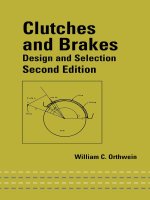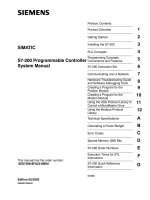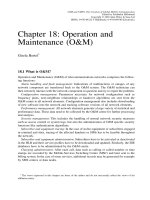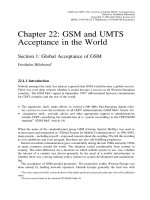Tài liệu Clutches and brakes design and selection P2 doc
Bạn đang xem bản rút gọn của tài liệu. Xem và tải ngay bản đầy đủ của tài liệu tại đây (626.38 KB, 14 trang )
2
BandBrakes
Bandbrakesaresimplerandlessexpensivethanmostotherbrakingdevices,
withshoebrakes,asperhapstheirnearestrival.Becauseoftheirsimplicity,
theymaybeproducedeasilybymostequipmentmanufacturerswithout
havingtopurchasespecialequipmentandwithouthavingtousefoundryor
forgingfacilities.Onlytheliningmustbepurchasedfromoutsidesources.
Bandbrakesareusedinmanyapplicationssuchasinautomatic
transmissions(Figure1)andasbackstops(Figure5—devicesdesignedto
preventreversalofrotation),forbucketconveyors,hoists,andsimilar
equipment.Theyareespeciallydesirableinthelast-mentionedapplication
becausetheiractioncanbemadeautomaticwithoutadditionalcontrols.
I.DERIVATIONOFEQUATIONS
Figure2showsthequantitiesinvolvedinthederivationoftheforcerelations
used in the design of a band brake. Consistent with the direction of rotation of
the drum, indicated by N, the forces acting on an element of the band are as
illustrated in the lower right section of Figure 2. In this figure, r is the outer
radius of the brake drum and F
1
and F
2
are the forces applied to the ends of the
brake band. Because of the direction of drum rotation, F
1
is greater than F
2
.
Equilibrium of forces in directions parallel and perpendicular to the tangent
to a typical brake-band element at its midpoint requires that
ðF þ dFÞ cos
du
2
À F cos
du
2
À A pwr du ¼ 0 ð1-1Þ
Copyright © 2004 Marcel Dekker, Inc.
F
IGURE
1 Band brakes used in an automatic transmission system.
Copyright © 2004 Marcel Dekker, Inc.
ðF þ dFÞ sin
du
2
þ F sin
du
2
À pwr du ¼ 0 ð1-2Þ
when the brake lining and the supporting brake band together are assumed to
have negligible flexural rigidity, where A represents the coefficient of friction
between the lining material and the drum, p represents the pressure between
the drum and the lining, and w represents the width of the band. Upon
simplifying equations (1-1) and (1-2) and remembering that as the element of
band length approaches zero, sin(du/2) approaches du/2, cos(du/2)
F
IGURE
2 Quantities and geometry used in the derivation of the band-brake
design relations.
Band Brakes 19
Copyright © 2004 Marcel Dekker, Inc.
approaches 1, and the product dF(du/2) becomes negligible compared to Fdt,
we find that these two equations reduce to
dF ¼ Apwr du ð1-3Þ
so that
F ¼ pwr ð1-4Þ
Substitution for pwr from equation (1-4) into equation (1-3) yields an
expression that may be integrated to give
ln F À ln F
2
¼ ln
F
F
2
¼ Au ð1-5Þ
where u is taken to be zero at the end of the band where F
2
acts. It is usually
more convenient to write this relation in the form
F
F
2
¼ e
Au
ð1-6Þ
which expresses the tangential force in the band brake as a function of
position along the brake.
We may find F
1
from equation (1-6) by simply setting u = a to obtain
F
1
F
2
¼ e
Aa
ða ¼ wrap angleÞð1-7Þ
Since this equation shows that the maximum force occurs at u = a, it follows
from equation (1-4) that
F
1
¼ wrp
max
ð1-8Þ
in terms of the radius r of the drum and the width w of the band. This equation
points out a disadvantage of a band brake: The lining wear is greater at the
high-pressure end of the band. Because of this the lining must be discarded
when it is worn out at only one end, or it must be reversed approximately
halfway through its life, or the brake must have two, or perhaps even three,
different lining materials with different coefficients of friction so that the lining
does not need to be changed as frequently.
The torque exerted by the brake is related to the band force according to
T ¼ðF
1
À F
2
Þr ð1-9Þ
Upon factoring out F
1
by referring to equation (1-7) and then replacing
F
1
by the right-hand side of equation (1-8), we get
T ¼ F
1
rð1 À e
ÀAa
Þ¼p
max
wr
2
ð1 À e
ÀAa
Þð1-10Þ
Chapter 220
Copyright © 2004 Marcel Dekker, Inc.
which gives the brake’s maximum restraining torque as a function of its
dimensions and its maximum compressive pressure. This equation may be
applied if the leading link can withstand the force F
1
= rwp
max
and if the band
is strong enough to support the force given by equation (1-6) for 0 Q u Q a.
A measure of the efficiency of a band brake is the ratio of the torque
applied by the brake to the torque that could be obtained if the force were
applied directly to the drum itself:
T
F
1
r
¼ 1 À e
ÀAa
ð1-11Þ
The maximum value of this ratio for a single-turn band brake is 0.998 when
A = 1.00. From the plot of this ratio, Figure 3, it is apparent that reductions in
the angle of wrap from 360j to 270j has relatively little effect on the efficiency
for A = 0.5 or greater. We also see that the brake should subtend an arc of
270j or more if degradation of the friction coefficient, perhaps due to a dirty
environment and infrequent maintenance, is to be expected.
F
IGURE
3 Efficiency (T/F
1
r) and force ratio ( F/F
1
) as a function of angle from the
leading end of the brake band.
Band Brakes 21
Copyright © 2004 Marcel Dekker, Inc.









